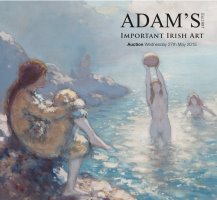
 66
Jack Butler Yeats RHA (1871 - 1957)
Roundstone, Connemara (1916)
66
Jack Butler Yeats RHA (1871 - 1957)
Roundstone, Connemara (1916)
Oil on panel, 23 x 36 cm (9 x 14”)
Signed, inscribed with title verso
Provenance: Bought by Oliver St John Gogarty at the 1918 Exhibition. Later in the collection of his daughter Mrs Desmond Williams, Tullamore.
Exhibited: “Jack B Yeats- Pictures in the West of Ireland” , Mills Hall, Dublin, Mar/Apr 1918, Catalogue No. 7
“Jack B Yeats - Loan Exhibition” Sligo Town Hall, organised by the Sligo Art Society August 1961, Catalogue No. 45
Literature: “Jack B Yeats - A Catalogue Raisonne of the Oil Paintings” by Hilary Pyle, Catalogue No. 102, page 89 (Vol 1)
Jack B. Yeats visited Roundstone in 1916 and recorded the landscape and the local people in his sketchbook. He produced half a dozen oil
paintings of the village and its surroundings. Hilary Pyle notes that in these works the artist paid more attention to the ‘rocky terrain then to
the sea, and [that] these landscapes have a narrative warmth that is very attractive.’
1
He knew the village well having stayed there before in
1911. Pyle also suggests that some of the views, perhaps this one, were influenced by postcards that Yeats collected and kept in his studio for
reference.
Roundstone, Connemara and a second landscape, A Wind-blown Tree, Roundstone were exhibited at a one-man show, Drawings and Pictures
of Life in the West of Ireland in the Mills Hall, Dublin in the spring of 1918, where they were bought by the surgeon and poet, Oliver St. John
Gogarty. A huge admirer of Connemara, Gogarty, a friend of W.B. Yeats, had acquired Renvyle House in 1917. Jack also knew Gogarty and
illustrated his 1918 volume, The Ship and Other Poems. Gogarty’s daughter, Brenda, later Mrs. Desmond Williams, inherited Roundstone, Con-
nemara and it was part of the Williams’s prestigious collection of Irish art for many years. Brenda, who trained as an artist, later made a very fine
bronze head of Jack B. Yeats.
Roundstone, Connemara depicts a line of houses silhouetted against a blustery cloud filled sky with a view of the Connemara Mountains
beyond. Built up in strong impasto paint, the solid forms of the buildings contrast with the patchwork of greys, greens and browns that is used
to construct the rock-strewn, sodden ground in front. A block of houses at right angles to the composition on the left enables Yeats to make an
intricate geometric formation of interlocking cubes. The dominant tawny coloured house near the centre of the painting adds to the diversity of
the architecture, subtly suggesting the social fabric of the town. This contrasts with Paul Henry’s contemporary representations of the West in
which little sense of such realities are to be found. In its resilient shapes and colour, Yeats’s painting encapsulates the intensity and movement
of the sky and the daylight in the West while, at the same time, it offers the viewer a modern and personal rendering of the distinctive topogra-
phy of Roundstone.
Roisin Kennedy
Dublin April 2015
1
Hilary Pyle, Jack B. Yeats. A catalogue raisonné of the oil paintings, Andre Deutsch, 1992, I, p.xxi.
€25,000 - €35,000



















